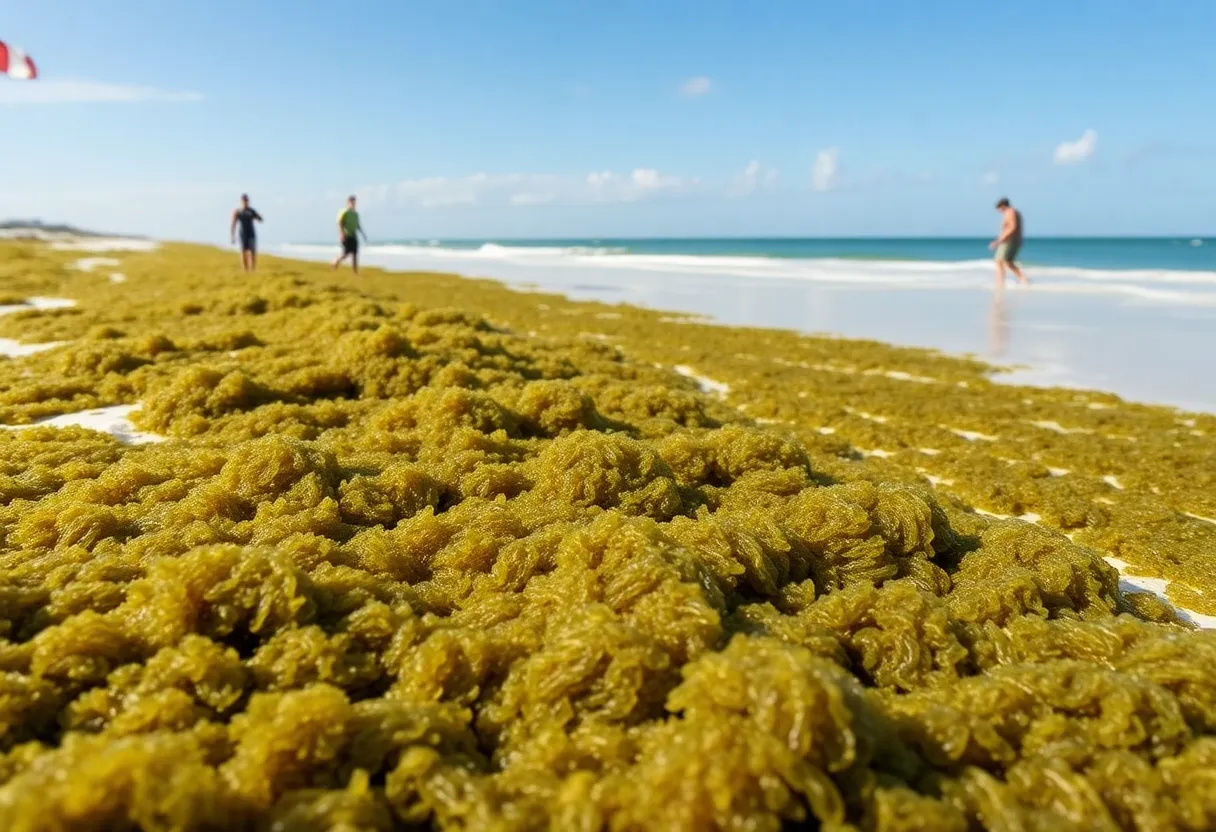News Summary
Florida is set to face an unprecedented invasion of sargassum seaweed, with forecasts indicating a record bloom impacting its beaches in the summer of 2025. Factors such as climate change are exacerbating the situation, leading to significant challenges for beachgoers and local governments. Experts are monitoring the effects on the marine ecosystem and exploring innovative recycling solutions for the seaweed. While the immediate inconveniences are evident, concerns about environmental impacts related to sargassum disposal highlight the complexities of addressing this phenomenon.
Florida is bracing for an unprecedented invasion of sargassum seaweed, with the University of South Florida (USF) forecasting a record-high bloom set to impact the state’s beaches in the summer of 2025. Experts predict that sargassum levels could see a staggering increase of 40% compared to the previous record established in 2022. In April 2025 alone, weed levels soared over 200% higher than the levels recorded the previous year during the same month.
The formation of this massive sargassum bloom is occurring earlier in the year than usual, with significant growth beginning in March and resulting in unprecedented levels reported by the end of April. Factors contributing to this alarming bloom include elevated wind patterns, nutrient enrichment in seawater, and rising temperatures, all exacerbated by the impacts of climate change. Higher water temperatures in the western Atlantic and Caribbean Sea are creating optimal conditions for the explosive growth of sargassum.
Beachgoers are already reporting challenges associated with the surge of sargassum. Many have noted difficulties swimming and coping with the potent odor emitted from decaying seaweed. This has led to increased health complaints among beach visitors, with some experiencing skin irritations caused by sea lice, which thrive in the environment created by the seaweed.
The financial burden of managing these vast seaweed blooms has already weighed heavily on local governments, with Miami-Dade County spending $2.8 million in 2020 and $3.9 million in 2022 on cleanup efforts alone. As for the costs associated with cleanup for 2025, those figures remain uncertain as municipalities prepare for what could be the largest influx of sargassum yet.
Beyond the immediate inconveniences, environmental concerns are also being raised regarding the potential consequences of decomposing sargassum. When managed improperly, this decaying seaweed can release methane, a potent greenhouse gas, into the atmosphere if disposed of in landfills. While the odor and effects on beachgoers are immediate, the long-term climate impact of improper sargassum disposal is a growing concern among environmentalists.
Despite the challenges posed by sargassum, some Florida residents – including tourists from Ireland – advocate for a more nuanced approach that recognizes the ecological benefits and potential applications of this marine resource. The Miami-Dade Innovation Authority is actively seeking solutions by funding start-up companies that are exploring processes for recycling sargassum. Innovations like converting the seaweed into fertilizers and biofuels are being trialed, with testing set for summer 2025.
Researchers at USF are employing satellite imagery to identify and quantify approximately 30 million metric tons of sargassum. However, while they can assess overall levels, it remains challenging to predict the exact impact of this significant biomass on Florida’s beaches. To tackle this issue further, the University of Miami is conducting research to enhance predictions related to the movement of sargassum and its potential arrival times on the coast.
Fishing communities are also feeling the effects of this ecological phenomenon. Charter boat captains recognize the important role that sargassum plays in the marine ecosystem, providing essential habitat for various marine life, even as they contend with its nuisance-level appearance affecting their operations.
Typically, local municipalities resort to disposing of large quantities of sargassum in landfills; however, this practice, while convenient in the short term, further complicates climate issues that have been increasingly associated with sargassum blooms. The phenomenon of seaweed blooms is not new; they have followed a recurring pattern in the Atlantic and are closely tied to surging nutrient pollution levels and warmer ocean temperatures caused by climate change. Predictions suggest that the peak of this impending sargassum bloom will occur in the summer, before beginning to decline in August and September. Moreover, the geographical distribution of sargassum washing ashore varies across Florida’s coasts, with the east coast typically experiencing higher concentrations due to prevailing ocean currents.
Deeper Dive: News & Info About This Topic
- Miami Herald: Florida braces for record-high sargassum bloom
- Fox 13 News: Record high amounts of sargassum expected on Florida’s east coast
- Weather.com: Florida braces for record bloom of sargassum seaweed
- Wikipedia: Sargassum
- Google Search: sargassum seaweed Florida
Author: STAFF HERE JACKSONVILLE WRITER
The JACKSONVILLE STAFF WRITER represents the experienced team at HEREJacksonville.com, your go-to source for actionable local news and information in Jacksonville, Duval County, and beyond. Specializing in "news you can use," we cover essential topics like product reviews for personal and business needs, local business directories, politics, real estate trends, neighborhood insights, and state news affecting the area—with deep expertise drawn from years of dedicated reporting and strong community input, including local press releases and business updates. We deliver top reporting on high-value events such as the Jacksonville Jazz Festival, Riverside Arts Market, and World of Nations Celebration. Our coverage extends to key organizations like the Jacksonville Chamber of Commerce and JAXUSA Partnership, plus leading businesses in logistics, healthcare, and entertainment that power the local economy such as CSX Corporation, Baptist Health, and VyStar Credit Union. As part of the broader HERE network, including HEREOrlando.com, HEREStPetersburg.com, HERETallahassee.com, and HERETampa.com, we provide comprehensive, credible insights into Florida's dynamic landscape.






